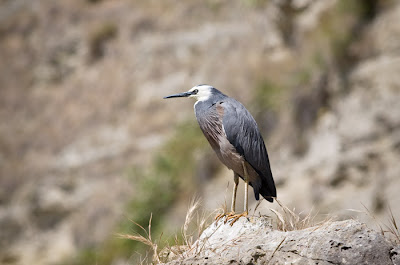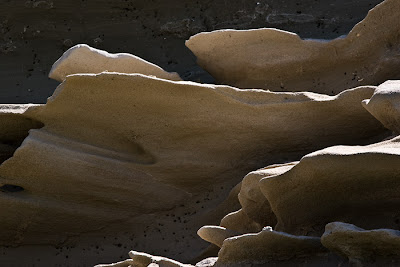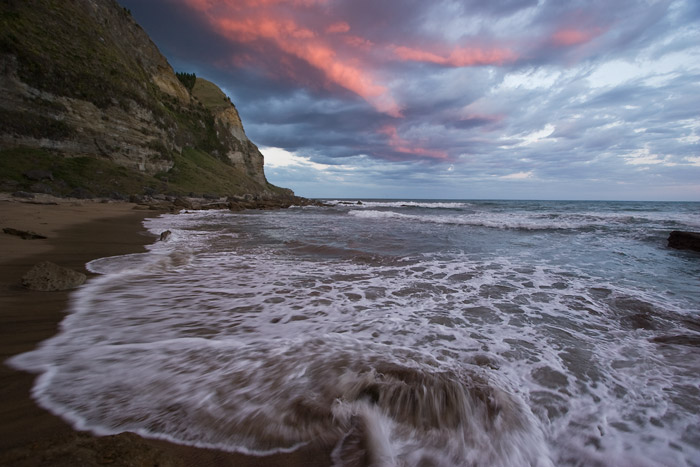—Tove Jansson; Moominvalley in November (1971).
 Places like this still exist in Aotearoa. Places still unsold to the foreign millionaire, to the new rich New Zealander with his four wheel drives, his architects with their white-concrete-and-glass statements, and his delight in ownership, success, control, and the best of everything. Places like this have not yet become playgrounds or reserves for privilege.
Places like this still exist in Aotearoa. Places still unsold to the foreign millionaire, to the new rich New Zealander with his four wheel drives, his architects with their white-concrete-and-glass statements, and his delight in ownership, success, control, and the best of everything. Places like this have not yet become playgrounds or reserves for privilege. Places like this, where three or four old caravans from the 1950s or '60s decay quietly in front of a line of old macrocarpas; where they blister and peel through the summers and leak and moulder during the winters, enduring the salt and storms lashed in from the sea beyond the spit. A bach with grimy windows and rusting iron keeps the caravans company; an old tractor rusts nearby, its perishing tyres slowly sinking into the accumulating sand. On the lagoon where the stream slackens and spreads before finally escaping through the sand bar to the sea, a small flotilla of black swans [1] rocks on the wind-chopped  water and four shags perch, heads drawn down onto their shoulders, on the emergent branches of a sunken tree. The wind scurries in from the sea, hissing over the sand, abrading and burying.
water and four shags perch, heads drawn down onto their shoulders, on the emergent branches of a sunken tree. The wind scurries in from the sea, hissing over the sand, abrading and burying.
Amelie lies half asleep in the sun, behind the big bleached driftwood log. Nowhere else on the beach offers any better shelter from the cold, incessant wind. We eat the bacon and salad rolls we'd prepared in the morning, and laugh about the telling off we'd received from the oystercatchers [2] further down the beach. I'd suspected a nest or chicks nearby, and sure enough, I happened to look across at the right time to see two small, fuzzy, speckled pompoms on legs trotting away along an old quad bike track in the sand. Then a third, a little way behind. We watched briefly through the binoculars, then hastened away to minimise the disturbance. Later we wondered at the adults' behaviour; how it seemed counter-productive — surely all the fuss would indicate to a predator that tasty morsels waited nearby? Surely, going about your usual activity would provide less incentive for any moderately bright predator to check the area more thoroughly? We walked on quickly until the agitated parents finally stopped following and circling us.
Halfway between the stream and our mediocre shelter behind the log, something pale and slightly gleaming lies on the sand. A fish, I assume, but when I put the binoculars on it, I see I'm wrong.  It's a dead penguin. Up close, it's identifiable as a little blue penguin [3], perhaps a day or two old. Lots of blowflies; a broken beak. I have no idea what killed it, but find the sight sad. The broken bill gapes open like a soundless scream.
It's a dead penguin. Up close, it's identifiable as a little blue penguin [3], perhaps a day or two old. Lots of blowflies; a broken beak. I have no idea what killed it, but find the sight sad. The broken bill gapes open like a soundless scream.
Fortunately, all the other birds in this place of birds are alive. White-faced herons [4] hunch on a massive rock near the beach; a pheasant [5] calls and beats his wings in the jungle of long grass and bracken and fallen branches behind the cabin and another calls from the wetland near the stream; swallows [6] flit in the early summer sky and yellowhammers [7] startle in the wind. Kereru, kotare, kahu [8]. The sparrows [9] here are so unafraid they'll almost (but not) land on an outstretched hand (food would have to be proffered, of course).
Gannets [10] cruise along the coast, sometimes coming in close as we walk the track below the cliffs and above the jumble of huge, fallen blocks of mudstone; as the big birds glide past on powerful, deliberate wingbeats, we can see the strong markings on the head, the streamlined bill and tapered wings; elegance to the point of perfection. Out at sea, one suddenly jinks, its wings folding as it flicks sideways and down, almost backwards, and begins to plummet towards the ocean. But it breaks from the dive and resumes its patrolling. A fish survives, somewhere down there in the silvery-blue sea. Two gulls fly low overhead and  settle at the edge of the surf by the mouth of the stream. Something about them seems to differ from the usual tarapunga, the red-billed gulls [11]. Of course! — the bills are intensely black; they're longer, more slender than the bills of tarapunga, and the legs and feet are also that deep black. They're black-billed gulls [12], the first I've seen in years; in fact, the first for which I've ever been confident in my identification — I suspect those I thought were black-bills, all those years ago when I was a kid, were probably juvenile red-bills. Amelie studies them through the binoculars. She too is delighted by the sighting. They seem distinctly more elegant than tarapunga, and when a pair of those hover overhead and alight on the sand only a few metres away, the difference in bill shape (not to mention the vivid vermillion compared to the basalt black) becomes strikingly obvious.
settle at the edge of the surf by the mouth of the stream. Something about them seems to differ from the usual tarapunga, the red-billed gulls [11]. Of course! — the bills are intensely black; they're longer, more slender than the bills of tarapunga, and the legs and feet are also that deep black. They're black-billed gulls [12], the first I've seen in years; in fact, the first for which I've ever been confident in my identification — I suspect those I thought were black-bills, all those years ago when I was a kid, were probably juvenile red-bills. Amelie studies them through the binoculars. She too is delighted by the sighting. They seem distinctly more elegant than tarapunga, and when a pair of those hover overhead and alight on the sand only a few metres away, the difference in bill shape (not to mention the vivid vermillion compared to the basalt black) becomes strikingly obvious.
If only the black-bills had settled where the tarapunga now strut, so close the head and shoulders of the nearer bird fill the viewfinder. I don't even bother trying to photograph the black-bills. Anyway, we're satisfied just to watch. Yet they're not rare, at least not in the North Island. Why haven't I seen them more often?  Maybe I have; maybe it's not a matter of seeing, but of noticing — maybe I've glanced and thought, “juvenile red-bills.” I'll look with more care from now on.
Maybe I have; maybe it's not a matter of seeing, but of noticing — maybe I've glanced and thought, “juvenile red-bills.” I'll look with more care from now on.
Now a pair of black-backed gulls [13] lands. Near the black-bills, the new arrivals look massive, almost ungainly. They're nesting along the coast; we saw two sitting as we walked here, and on our return both birds have left their nests, revealing, in each, three grey-green, black-speckled eggs. Again, we don't tarry, allowing the adults to circle and settle. I wonder how safe the oystercatcher chicks might be with these birds around, or with the ever-present, slowly circling kahu with its marvellously keen eyesight. It's part of life I suppose; one bird becoming another; life and death as transformation. Sentiment, sometimes excruciatingly painful, is uniquely human.
Out at sea a few clouds darken the water from turquoise to aquamarine, and away North the line of coastal cliffs recedes into the blue haze of distance, like the impossible knowledge of the future — when you get there, it's solid beneath your feet but from here, now, it could be almost anything.
here, now, it could be almost anything.
“Guess how many settlements there are along the coast from here to Moanaroa,” Amelie says.
“One?”
“None. Maybe the odd hut or house, but no towns, nothing like back at the beach.” She estimates the distance, then adds, “Wouldn't it be wonderful to walk all the way there?”
I look at her and do a quick calculation of how many days it might take. Perhaps the better part of a week? There'd be rivers to cross, of course, and some of the headlands might be impassable along the coast, but I wonder what it would be like to wander for a week beside the sea, meeting only an occasional farmer, someone fishing, perhaps a distant glimpse of a white-haired hermit moving slowly out of sight like some ghost from an old world. For me, the question doesn't even need an answer.
Places like this still exist in Aotearoa.
 Notes:
Notes:
Place names have been changed. Bird names are accurate to the best of my knowledge.
1. Cygnus atratus. Black swans, although deliberately introduced to New Zealand in the 1860s, probably arrived naturally from Australia about the same time. They're now widespread throughout the country.
2. Haematopus unicolor, the endemic variable oystercatcher (torea), often called black oystercatcher (toreapango) in the completely black phase (the birds we saw this day). I was startled to discover later that they're considered rare, with a total population of about 4000 birds. Despite this, I've found them to be easily seen along the Wellington coast — walk South from Eastbourne, for example, and you'll definitely see them.
3. Eudyptula minor. On the last evening we walked to the small bay South of the beach; there, while I stood on a car-sized rock with the surf surging below me, a blue penguin bobbed and dived and swam, as unsinkable as a cork, only a few metres out and immediately in front of me. It seemed like a gift; as if the land and sea and sky were saying, “Remember us.”
4. Ardea novaehollandiae, often called the blue heron, a colloquial name formerly used (but now discouraged) for the much rarer reef heron (Egretta sacra). Self-introduced from Australia in the mid 20th Century and now the most common New Zealand heron.
5. Phasianus colchicus.
6. The welcome swallow, Hirundo tahitica.
7. Emberiza citrinella. Introduced in the late 19th century and now widespread.
8. Kereru, kotare, kahu: respectively, the native pigeon Hemiphaga novaeseelandiae; the kingfisher Halcyon sancta; the harrier Circus approximans.
9. House sparrows, Passer domesticus.
10. Takapu, Australasian gannet, Morus serrator.
11. Larus novaehollandiae.
12. Larus bulleri.
13. Karoro, Larus dominicanus.
Photos (click to enlarge them):
1. On the cliffs above the small South bay; the last evening.
2. Same place, same evening.
3. White-faced heron.
4. Wind sculpted cliffs on the way to the northern bay.
5. On the beach at the northern bay.
6. Main beach, evening.
7. Birds weren't the only animals around.
Photos and words © 2007 Pete McGregor
13 comments:
Only time for a hasty read through at the moment, Pete, but I'll be back to savour this, words and photographs, when I have time to do it all justice. You're well out of the writing doldrums now, it seems, and under full sail again!
I love the Moomintroll books. With no young children in my own family, I've been buying some for a friend's daughter and having a sneak read before posting them off. I was so pleased to discover they're still available.
P.
Good to know. Sad that it's so rare.
Such beauty - nearly painful.
The apparent simplicity of your words matches the superb photography so well. A breath of wonderful summer sea air for the landlocked in winter. Thank you!
As I sit in Montreal with snow swirling and drifting around the terrace, you've taken me to this amazing place. What a wonder this medium can be! And not only is the image of this place very beautiful, you've introduced me to some creatures I've never known or seen, like that white-faced heron. I hope you get to do that week-long walk.
Pete, I'm not sure which I enjoyed most - your photos or your words. Thank you for showing us this wonderful place through your eyes.
What an amazing place we live. I have climbed in the mountains and camped by the sea on the same day. You point out the so many things I never see, yet are right in front of my eyes.
It has been somewhat sad to see some of the very aspects of living in America that happily drove me here start to arrive. Yet does my soul good to know it has not yet invaded everywhere. Thanks again Pete.
My hopes for the long term of this planet are fading, but a lovely post like this buoys them up a bit.
Thanks.
Apologies for the delay in responding. I returned yesterday after four days helping the Department of Conservation survey Ruahine rivers for whio. Photos will appear soon :^D
Peregrina, I credit the Moomintroll books with boosting my reading ability when I was just learning. The whimsical little drawings and perhaps one or two words convinced me I wanted to read them, so I struggled through Comet in Moominland and a few others. By the time I'd managed them, I was reading pretty well for my age.
Zhoen, these places can still be found, but it's getting harder. The power of the dollar/euro/yen/whatever is as strong as ever, and getting rich by "developing" property (including land) seems to be increasingly fashionable here. But what can be done? How do we resist?
Emma, thanks. :^)
R.R., glad it helps keep you warm. Six months from now, I'm likely to be asking for words from you to keep me warm.
Beth, thanks. The walk is certainly a possibility, but even if it doesn't happen, I'm sure I'll be back on that coast before too long.
Anne-Marie, I hoped that you in particular, as one who knows that coast well, would appreciate the post. Thanks :^)
Robb, it's not just the US (although that's perhaps the prime model): it's rampant capitalism and the lust for ever-increasing material ownership, and that seems to pervade most societies now. However, although I referred to clean, clear, safe water when (in the previous post) I said "Such things are possible," I do suspect a more common dream is what's commonly referred to as "the American Dream". But I'm happy to say all the people I know here who have come from the US appreciate and value these places the way you do. Good onya, mate!
Isabelita, thanks. It's certainly easy to become pessimistic, but I think it's desperately important not to let pessimism degenerate into despair, because that leads to apathy, to inaction. It's easy to notice things about which to become despondent, but there's at least as much in which to rejoice. Climbing, for example ;^P
Pete, It feels almost miraculous to me to have a friend in such a distant and rapturous spot, a friend who would pray over his cup of tea if he knew who to pray to. (Somehow that inclination, as well as your photographs, seems to me the among the sincerest forms of prayer.) I came here partially to thank you for all your good wishes, but mostly to answer a comment you left on my blog. You said you wished you could share all you have with the world. As one who has been awed by your work here for some time, I could not let that pass. You have and you do--more than you know.
Patry! Given all you're going through, I never expected you to take the time to visit here. But I'm so glad and honoured you did; so pleased you allowed me to share my world. Thanks for your visit and generous comment, and very best wishes to you and the family for your quick and full recovery.
I'm just catching up on my reading tonight. Very distressing how seashore, lakefront, river and other property is being grabbed and churned into private enclaves or chopped up by developers. My last couple of visits to the western U.S. have left me with feelings of dread at how quickly forests and shorelines can be forever destroyed.
As always, I am awed by your photography.
Bev, thankyou. If the changes were reversible they'd still deeply sadden me, but it's difficult to describe how I feel knowing the damage can't be repaired without unimaginable changes to our society — or, in many cases, ever.
Post a Comment